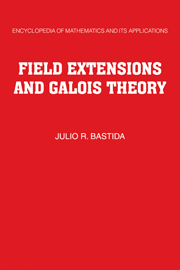Book contents
- Frontmatter
- Contents
- Editor's Statement
- Section Editor's Foreword
- Preface
- Historical Introduction
- Prerequisites
- Notation
- Field Extensions and Galois Theory
- Chapter 1 Preliminaries on Fields and Polynomials
- Chapter 2 Algebraic Extensions
- Chapter 3 Galois Theory
- Chapter 4 Transcendental Extensions
- References and Selected Bibliography
- Index
Historical Introduction
Published online by Cambridge University Press: 05 June 2013
- Frontmatter
- Contents
- Editor's Statement
- Section Editor's Foreword
- Preface
- Historical Introduction
- Prerequisites
- Notation
- Field Extensions and Galois Theory
- Chapter 1 Preliminaries on Fields and Polynomials
- Chapter 2 Algebraic Extensions
- Chapter 3 Galois Theory
- Chapter 4 Transcendental Extensions
- References and Selected Bibliography
- Index
Summary
Problems of geometric construction appeared early in the history of mathematics. They were first considered by the Greek mathematicians of the fifth century B.C. Only two instruments—an unmarked ruler and a compass—were permitted in these constructions. Although many such constructions could be performed, others eluded the efforts of these mathematicians. Four famous problems from the period that remained unsolved for a long time are the following: doubling the cube, which consists of constructing a cube whose volume is twice that of a given cube; trisecting the angle; squaring the circle, which consists of constructing a square whose area is that of a given circle; and constructing regular polygons.
At the end of the eighteenth century, when it was observed that questions on geometric constructions can be translated into questions on fields, a breakthrough finally occurred. The 19-year-old Gauss [2: art. 365] proved in 1796 that the regular 17-sided polygon is constructible. A few years later, Gauss [2: art. 365, 366] stated necessary and sufficient conditions for the constructibility of the regular n-sided polygon. He gave a proof only of the sufficiency, and claimed to have a proof of the necessity; the latter was first given by Wantzel [1] in 1837. In his investigations, Gauss introduced and used a number of concepts that became of central importance in subsequent developments.
- Type
- Chapter
- Information
- Field Extensions and Galois Theory , pp. xxi - xxivPublisher: Cambridge University PressPrint publication year: 1984



